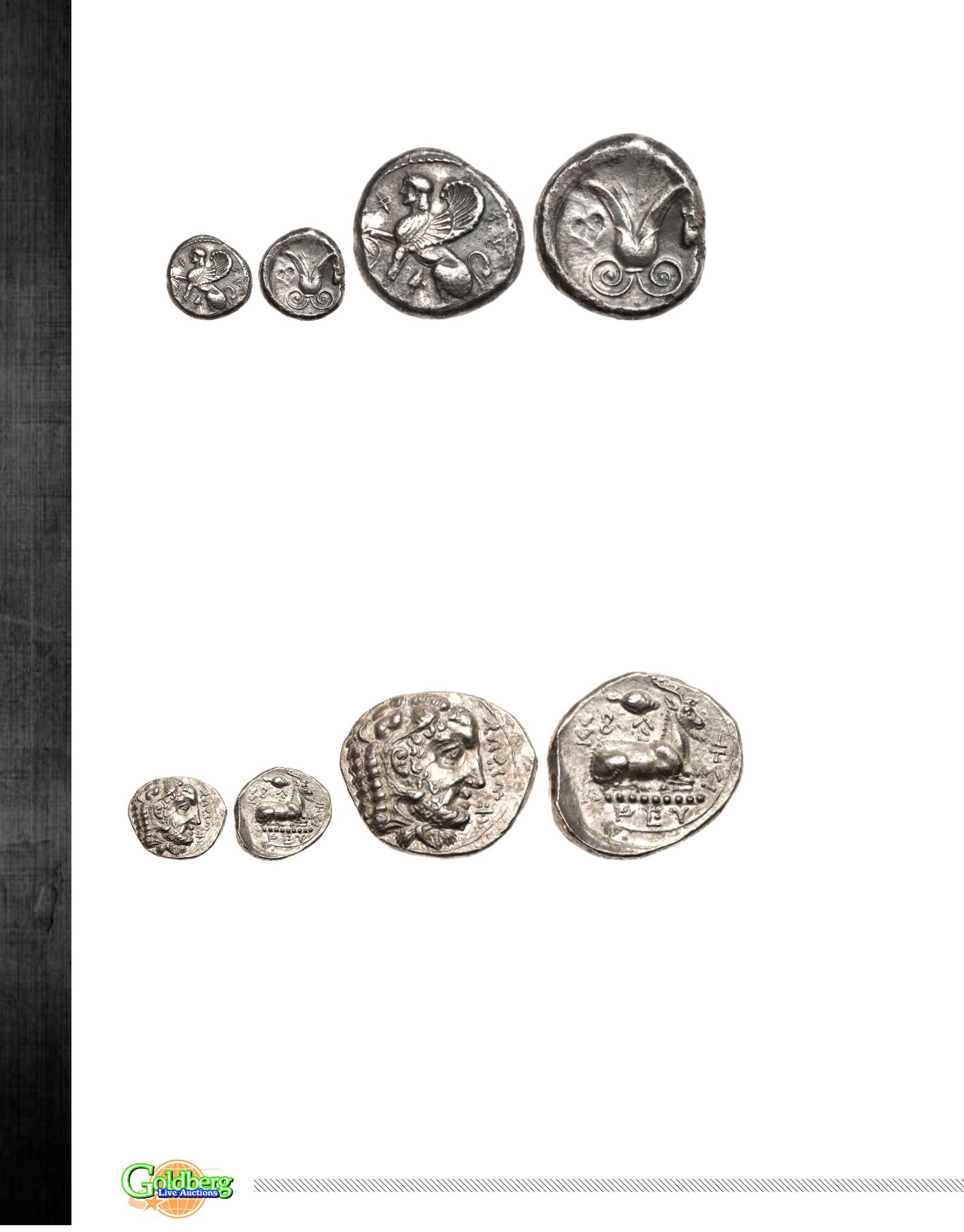

101
|
Session Five - Tuesday, February 14th 10:00am PST
E
X
L
OCKETT
- C
YPRUS
, I
DALION
S
ILVER
S
TATER
,
CA
. 470-460 BC
Enlargement
1760 Cyprus, Idalion. Uncertain king. Silver Stater (10.79 g), ca. 470-460 BC
. Sphinx seated left, raising forepaw.
Reverse:
Lotus flower; in
inner left field, incuse ivy leaf; in right field, astragalos. Tziambazis 43 = BMC 10; SNG Copenhagen -.
Very Rare.
Well struck. Mottled greyish
toning.
Choice Very Fine
.
Estimate Value ....................................................................................................................................................................... $2,500 - 3,000
From the Hanbery Collection; Purchased privately from F. Kovacs in the 1980s; Ex BMC and Ex Richard Cyril Lockett Collection.
The Sphinx of Greek mythology was a monstrous creature composed of the head a woman, the body of a lion and the wings of an eagle that orig-
inated in Aethiopia. It has been suggested that the name of the Sphinx was derived from the Greek verb
sphingo
("to throttle") or that it rep-
resents a corruption of the Egyptian word
shesepankh
("living image") since the idea of the Sphinx almost certainly comes from early Greek
exposure to Egyptian culture.The Greek mythographers, poets, and the Theban cycle of tragedies by Sophokles report that the Sphinx was
brought by Ares or Hera to Thebes to serve as a curse on the city. It asked a riddle of all who wished to enter the city and if they could not give
the correct answer the Sphinx promptly devoured them. Many died satisfying the hunger pangs of the ferocious creature until Oedipus arrived.
When the Sphinx asked him "What walks on four legs in the morning, two at noon, and three at night?" he responded "Man," since as a baby, he
crawls, as an adult he walks, and in old age he requires the help of a cane. Oedipus' answer lifted the curse of the Sphinx from Thebes and
resulted in his acclamation as king (but in the process he married the widowed queen who, unbeknownst to him at the time, was actually his
mother, thereby setting off a whole new curse on the city). Despite the Theban focus of the Sphinx myth, the monstrous creature enjoyed a wide
popularity in Greek art and coinage. The Sphinx became the civic badge of Chios early on and as such may have influenced the development of
the attractively Classical Sphinx type of this coin of Idalion, although Egyptian-style sphinxes were already a staple feature of the city' s art in the
eighth century BC if not earlier (see for example the silver Idalion Cup in the Louvre).
V
IRTUALLY
A
S
S
TRUCK
- S
ALAMIS
E
VAGORAS
I S
ILVER
S
TATER
CA
. 411-374 BC
Enlargement
1761 Cyprus, Salamis. Evagoras I. Silver Stater (10.53 g), ca. 411-374 BC
. ' Euagoro' (Cypriot), head of Herakles to right, wearing lion' s skin
headress.
Reverse:
' Basileus' (combined Cypriot and Greek letters), ibex recumbent right on dotted ground line; above, barley corn; to right, two
letters. Masson & Amandry 36, II.B.c.1; de Hirsch 1614.
Very Rare.
Light grey toning. Virtually as struck.
Superb Extremely Fine
.
Estimate Value ........................................................................................................................................................................... $3,000 - UP
From the Hanbery Collection; Purchased privately from F. Kovacs in 1991.
Like most coins struck on Cyprus during the Classical period, this stater carries inscriptions written in the local Cypriot syllabic script, rather than
any of the familiar Greek alphabetic scripts. Although the legends name Evagoras I on the obverse and give his royal title (Basileus) in a Greek dia-
lect known as Arkadocypriot on the reverse, they are expressed using a series of glyphs representing syllables rather than individual letters. The
Cypriot syllabic script evolved from the Linear B script of the Bronze Age Mycenaeans and the time of Schliemann' s Trojan War. While this coin is
traditional in its use of the ibex badge of Salamis on the reverse and the retention of the syllabic script, Evagoras also began to issue coins that
also included abbreviated legends in alphabetic Greek. For initiating this process of "modernization" and introducing other aspects of mainstream
Greek culture to Salamis, he was praised as a model ruler by the Athenian orator Isokrates. Evagoras I marked the beginning of the end for
Cypriot syllabic writing. By the late third century BC it had all but vanished.



















